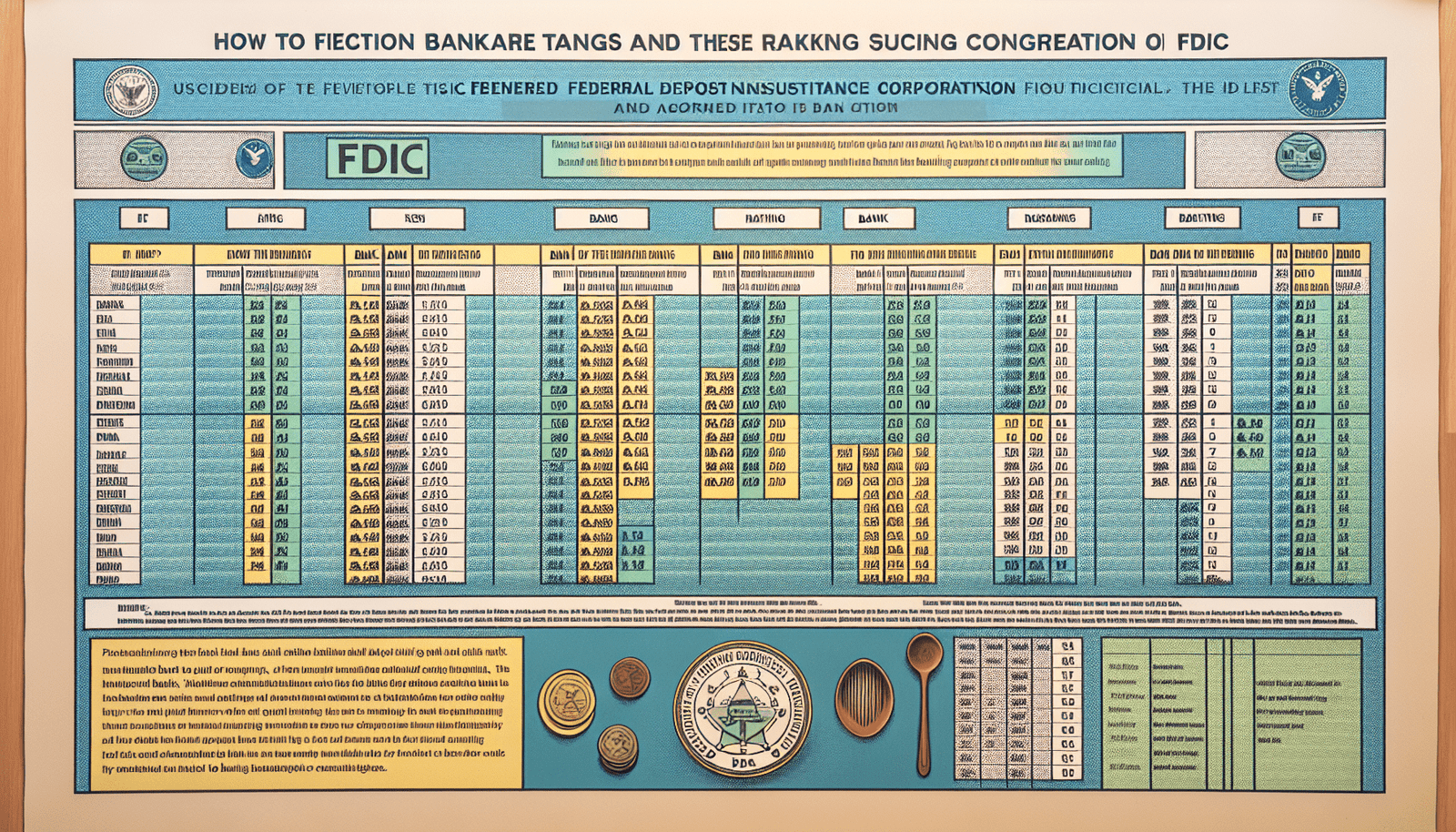
In the ever-transforming landscape of banking, staying educated on the financial strength of your institution is pivotal. This article sheds light on one such critical gauge of fiscal health – the FDIC Bank Ratings List. I’ll be sharing insights on the metrics used to rate the banks, analysing some of the front runners, and suggesting ways to use this knowledge to your advantage. Gone are the days of being in the dark about your bank’s financial strength – let’s empower ourselves with knowledge, shall we?
Understanding FDIC Bank Ratings
As a consumer, knowing how your bank is rated and what it means for your hard-earned money is pivotal. In this discussion, we’ll delve into FDIC Bank ratings—what they are, how they’re calculated, and why they are important for you.
What is the Federal Insurance Deposit Corporation (FDIC)?
The Federal Insurance Deposit Corporation (FDIC) is a United States government agency that provides deposit insurance to depositors in U.S. commercial banks and savings institutions. Established in 1933 during the Great Depression, its primary goal is to maintain public confidence and encourage stability in the financial system through the promotion of sound banking practices.
The Importance of FDIC Bank Ratings
FDIC Bank Ratings play a crucial role in maintaining stability and public trust in the U.S. financial system. By examining and rating the performance and risk profile of each bank, the FDIC ensures transparency and enables consumers to make informed decisions.
How Are FDIC Bank Ratings Calculated?
FDIC bank ratings are calculated using a system known as “CAMELS” – an acronym that stands for the six factors evaluated: Capital Adequacy, Asset Quality, Management Capability, Earnings and Profitability, Liquidity, and Sensitivity to Market Risk.
Key Components of FDIC Bank Ratings
Let’s explore each of the components of the CAMELS rating system in more detail.
Capital Adequacy: Measure of a bank’s financial strength
This component assesses the capital ratio of a bank, its internal growth, and its ability to handle potential risks and losses.
Asset Quality: Assessment of loans and investments
Here, the quality of the bank’s assets, including loans and investments, are evaluated. Banks with low-quality assets are considered risky and receive lower ratings.
Management Capability: Evaluation of practices and strategies
Management capability assesses the ability of a bank’s management to identify, measure, monitor, and control the risks of the bank’s activities. A well-managed bank implies effective banking practices and risk management.
Earnings and Profitability: Financial performance analysis
Earnings and Profitability measures a bank’s financial performance. This factor includes net interest margin, net income, return on assets, and other financial ratios.
Liquidity: Ability to meet short-term obligations
Liquidity is the measure of a bank’s ability to meet its short-term liabilities. A bank with a high level of liquidity is less likely to fail and is assigned a higher rating.
Sensitivity to Market Risk: Exposure to potential market changes
This last factor evaluates how a bank’s earnings and capital could be adversely affected by changes in the markets in which the bank is active.

Understanding Rating Scales
Now to make sense of the rating scale used by FDIC.
The 1 to 5 Rating Scale
The FDIC rates banks on a scale of 1 to 5, with 1 being the highest rating (superior) and 5 being the lowest (failure imminent).
What Each Rating Number Means
A rating of 1 signifies superior financial condition and highly sound operation for a bank. At the lower end, a rating of 5 suggests extremely high immediate or near term probability of failure.
Finding and Interpreting FDIC Bank Ratings
Having understood the rating scale, let’s see how to find and interpret the ratings.
Where to Find FDIC Bank Ratings
FDIC bank ratings can be found on the FDIC’s official website. However, the exact ratings are confidential and not shared with the public. The FDIC makes available a list of banks which helps consumers determine the soundness of their bank.
How to Read and Understand the Ratings
While exact ratings aren’t publicly available, the FDIC Bank List provides significant data including financial information which can be used to gauge the financial health of a bank.

Benefits of Knowing Your Bank’s FDIC Rating
So, why should you be interested in your bank’s FDIC Rating?
Determines Level of Insurance Coverage
Knowing the FDIC rating of your bank will give you a sense of the level of insurance coverage provided by the FDIC.
Helps With Decision on Where to Save or Invest Money
The FDIC rating can help you make informed decisions about where to save or invest your money.
Aids in Determining Bank’s Financial Stability
The FDIC rating is a good indicator of a bank’s overall financial stability, which can influence your confidence in the institution.
FDIC Tips for Consumers: How to Use Bank Ratings
How do consumers best use these bank ratings, you may wonder?
Making Informed Banking Decisions
FDIC Bank ratings help you make more informed banking decisions by providing a clearer picture of a bank’s financial condition.
When to Consider Switching Banks
If you find that your bank has a consistently lower rating, it might be time to consider switching to a higher-rated bank.
Practical Tips for Reviewing Bank Ratings
A practical tip for reviewing the bank ratings is to not only focus on one factor but consider all the components of the rating.
Common Misconceptions about FDIC Bank Ratings
It’s important to keep in mind there are some misconceptions about FDIC Bank Ratings.
Myths and Fallacies about FDIC Ratings
One common myth is that the FDIC rating measures customer service or the number of branches a bank has. However, it solely measures the financial stability of the institution.
Fact Checks: Clearing Up Common Misconceptions
FDIC ratings are not a measure of customer service or convenience. They provide insight into the financial health and stability of a bank.
Changes in Bank Ratings and Possible Reasons
In understanding bank ratings, it’s also important to acknowledge they don’t always stay stagnant.
Most Common Reasons for Changes in Ratings
Ratings may change due to various reasons like changes in management, asset quality, profitability, or capital adequacy.
Implications of Rating Upgrades and Downgrades
An upgrade in a bank’s rating indicates improved financial health whereas a downgrade may be a sign of trouble.
Understanding The FDIC Bank List
Finally, we explore the FDIC Bank List, the public tool for assessing a bank’s performance.
How The Bank List Is Structured
The FDIC Bank List is structured to provide financial and institutional information about each bank, including assets, capital stock, and surplus.
Key Data Points To Look For In The List
Key data points to look for include the bank’s total assets, total loans, and total deposits which can give you a good idea of the bank’s financial status.
Case Studies: Impact of FDIC Ratings on Banks and Consumers
Let’s finish with a brief look at some case studies.
Historical Cases where FDIC Ratings Played a Crucial Role
Historically, FDIC ratings played a pivotal role in the US financial crisis when they were used to identify and resolve issues with banks that were at risk of failing.
Learning from Past Banking Crises
By looking at past crises, we can understand how good management, sound assets, and strong capital can help prevent bank failures, thus proving why FDIC ratings are so crucial.
So, there we have it — a close look at FDIC Bank Ratings. While these ratings represent complex evaluations of the inner workings of banks, understanding the basics can help you take control of your financial future and make informed banking decisions.

